The Snapdragon 845 Performance Preview: Setting the Stage for Flagship Android 2018
by Ryan Smith & Andrei Frumusanu on February 12, 2018 12:30 AM EST- Posted in
- Mobile
- Snapdragon
- Qualcomm
- Smartphones
- SoCs
- Snapdragon 845
System Performance
To see how the new CPUs and memory subsystem translate into more real system performance, we move onto more representative tests such as PCMark. PCMark’s performance is affected by several factors: not only does raw performance of the hardware count but also we need to consider the individual system’s software stack. We’ve seen large differences between Android OS major versions where the improvements of the Android Runtime can be directly visible in subtests such as the Writing test. Also a SoC’s DVFS schemes and schedulers can have huge impacts on “performance-latency”, meaning how fast the CPUs can ramp up a workload. This directly translates in a lot more performance in several of PCMark’s subtests as in the default settings none of the tests actually represent the pure performance of the CPU if it were locked at maximum frequency on the performance cores. The results of the tests are also overall a good representation of “snappiness” of a device.
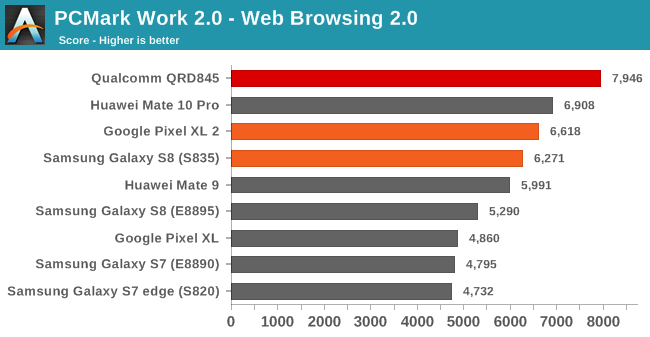
In the web browsing test the Snapdragon 845 QRD manages to outpace the Pixel 2 XL by 20%. Here we’re also looking at performance across devices with different OS versions. The Google devices are running Android 8.1 while the Samsung devices were tested with Android 7.0. The Mate 10 Pro runs Android 8.0 while the Mate 9 still had 7.0. The Qualcomm QRD we tested ran Android 8.0.
Again the performance increase over Snapdragon 835 devices isn’t all that great. DynamiQ allows for far more efficient thread transitions between the CPU cores and subsequently I expected Qualcomm to take advantage of this through more aggressive scheduling resulting in more than just a 20% increase. The difference between the Mate 9 and Mate 10 here is a good example of what a software configuration change can bring in terms of performance (both devices employ same performance CPU configurations). Samsung’s Exynos’ SoCs still use GTS scheduling and have non-optimal performance-latency resulting in bad scores, amplified by the fact that Samsung’s memory performance is also underwhelming when compared to the Snapdragon and Kirin SoCs.

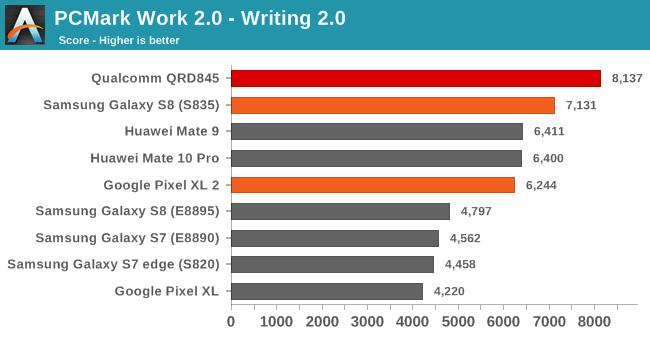
The Data Manipulation and Writing 2.0 tests make heavy use of the Android runtime and APIs and also a very memory latency sensitive. Between the best showings of the Snapdragon 835 variant of the S8 and the Pixel 2 XL in each respective benchmark, the Snapdragon QRD845 showed conservative increases of 8 to 14%. The Exynos SoCs lacklustre performance is again hampered by software and by bad memory performance.
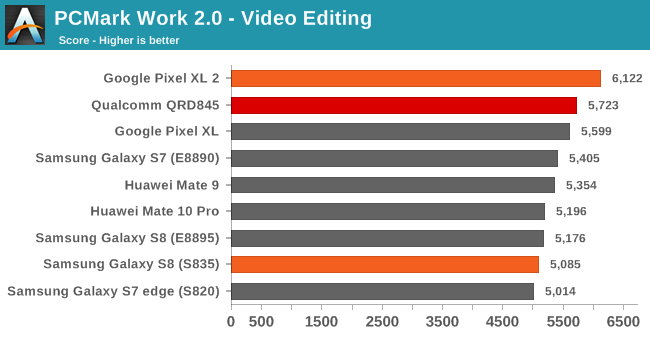
The video editing test is PCMark’s weak-point as it’s bottlenecked by things such as OS API overhead, and why we see tight grouping of performance results across a large range of SoCs. The Snapdragon 845 ends up high, but below the Pixel 2 XL. I would not put much weight on the results of this test as they’re not necessarily representative. Futuremark claims that the test is a lot more sensitive in mid- and low-range devices which can exhibit performance issues.
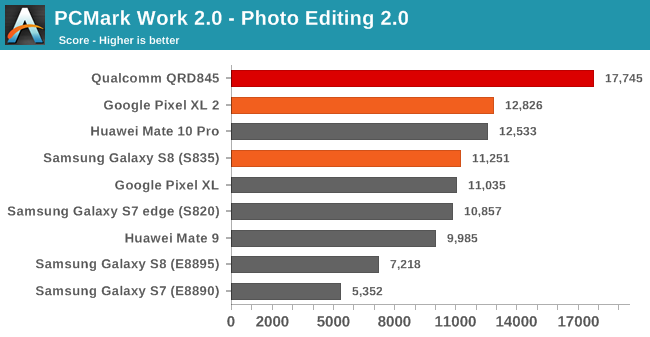
The photo editing test makes heavy use of Renderscript and use GPU acceleration to apply various effects on an image set. The QRD845 here shines as it’s able to showcase a 38% performance improvement over the Pixel 2 XL. Again the test not solely tests the raw performance of the system but also how optimized it is in terms of the software stack. This can be seen in the Kirin vs Exynos devices as Huawei’s phones vastly outperform Samsung’s devices in this test.
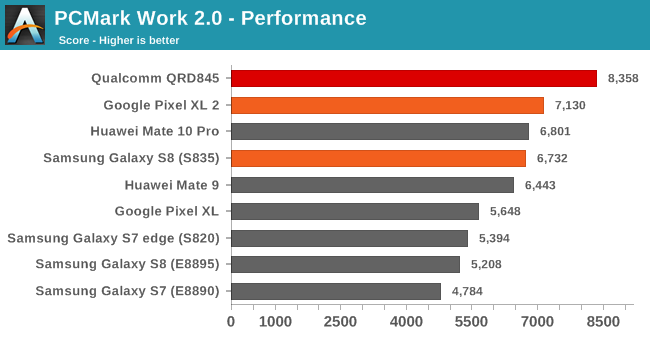
Overall PCMark’s performance score for the QRD845 increases by 17% over the Pixel 2 XL. Disregarding the video test, we see a similar scenario as in the synthetic tests as the new SoC’s CPU performance increases are lower than we had expected. Still the Snapdragon 845 is able to top the charts and should adequately power 2018’s flagship devices.
For 2018 we are reviewing our mobile benchmarking suite and altering some of the benchmarks we use. One of the changes in the way we benchmark devices is that we’re moving away from standalone browser and rather are benchmarking the OS’s WebView implementations. In general this seems to be a better choice for testing device experience as there is a lot of content that is being consumed via WebView windows. We also avoid the argument about different browser performance and since Google has now made WebView an updatable Play Store component we should also have valid comparisons older devices and systems. On the iOS side we do the same as we now benchmark browser tests within a WkWebView shell.
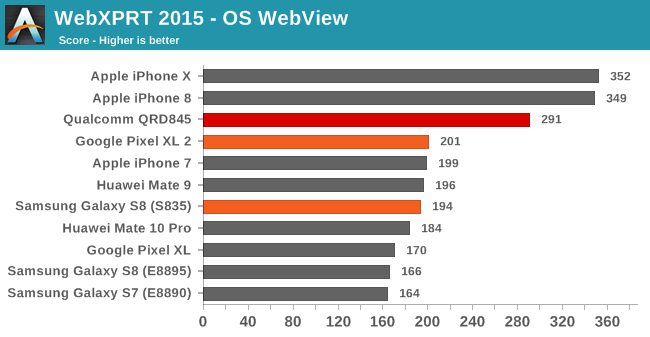
Starting off with WebXPRT 2015 for a last time before we’ll retire it in favour of WebXPRT 3, we see the QRD845 performing fantastically. Here the 44% performance increase over the Pixel 2 XL is a lot more in line with what we had expected of the new SoC. The QRD845 is even able to catch up a lot with Apple’s newest A11 and Monsoon cores in this test.
To keep up with the ever changing landscape of the developing web, we’re also retiring past JavaScript benchmarks in favour of a brand new and more representative benchmark developed by the WebKit team and welcomed by Google; Speedometer 2.0.

Here the Snapdragon 845 showcased another healthy performance increase of 37% over the Snapdragon 835 devices. Apple’s superior JavaScript performance can be attributed to a much faster and more optimized Nitro engine while Google’s V8 has only seen meagre improvements over the years. Notable is the Apple A11’s massive performance jump over the A10 – vastly increasing the distance to Android devices.










140 Comments
View All Comments
Lodix - Monday, February 12, 2018 - link
That they make their own chip.ZolaIII - Monday, February 12, 2018 - link
Actually A75 is a bit of a let down. As it's actually refined A73 with tree instructions per clock vs two. I assume that with larger cache, bigger predictor & everything else it's also close of being 50% larger while it's able to achieve only 20~25% performance advantage. Nevertheless if compared to A71 which is similar 3 instructions per clock design advantage is nice 30~35%. Neither is really a server material & you know that pretty good (of all people around hire). We will have to wait & see what Austin will cook up next.ZolaIII - Monday, February 12, 2018 - link
One more thing FP VFP & especially NEON got a most significant boost with A75 - A73, that's actually only really architectural improvement on this generation. FP performance is very important as it scales rather good on the SMP while integer doesn't. Still giving MP scaling factor & relative power efficiency/performance the A55's are still much better target for such workloads using 25% power & achieving 85% performance per MHz. Arm's NEON SIMD whose marginally unusable before this gen. as on the previous VFP had 98% of NEON performance while (VFP) being much faster to access so in many real workloads actually faster. ARM boosted NEON performance but in my opinion not even close enough to go in a higher tear. I do agree with you that Integer performance is actually rather very good for small, efficient little OoO core but ARM must do much more on the FP - NEON SIMD if it wants that their cores become more competitive in HPC segment. Actually I see this as a key (FP performance). Hopefully they will produce a next key architectural element of unified SIMD with added multiply, divide subs on it as I see that as the best possible scaling/performance improvement & also as future avoiding of black silicone. Actually regarding large NEON SIMD blocks usage & in the purpose of server scientific HPC workloads the Fujitsu started working on it long time ago (two + years ago). I just wonder what happened with that.iter - Monday, February 12, 2018 - link
You are confusing integer and floating point with scalar and vector. SIMD units do vector processing, the vector components can be either integer or floating point. Both are equally useful in HPC, and both get a massive boost from SIMD processing. It is the ALU and the FPU units that do scalar processing, that is one number at a time, of integers and floating point numbers respectively. Those are not used for data crunching, but for managing the program flow, which is beneficial since the lower throughput also means lower latency.There is no such thing as a free lunch here. If you want to stay at a lower power target, you have to compromise on the SIMD throughput. There is no way to cheat around that. If ARM chips get SIMD units to match x86 counterparts they will also match their higher power usage.
ZolaIII - Monday, February 12, 2018 - link
Lol both scalar and vector are FP. I ain't confusing anything, you are... SIMD's are rather efficient, more efficient for an order of magnitude compared to the VFP, that's why SIMD arias find their way to pretty much any special purpose or general purpose computing unit's. What I told is a massive united heterogeneous SIMD aria... Now think about it.iter - Tuesday, February 13, 2018 - link
You are such a dummy. Scalar means "one number", vector means "two or more numbers". The number can be an integer or a floating point number. SIMD instruction sets feature dozens of instructions for processing integer numbers, which are essential to image, video and audio processing, which is all stored using integers.In fact, the first SIMD implementation to hit consumer products was intel's MMX, which provided ONLY INTEGER operations.
As I said - scalar operations involve processing one number of a time, and are executed by the ALU or FP unit for integers and real numbers respectively, vector operations involve processing multiple numbers at once, and is handled by the SIMD units, regardless of whether its integers or reals.
lmcd - Monday, February 12, 2018 - link
Wouldn't get too excited, as A75 was reported to feature a variant of the "Meltdown" bug also affecting Intel CPUs. Performance hit for a patch could be damaging.SirPerro - Monday, February 12, 2018 - link
I'm more interested in the mid-range processors to drive devices like the Moto G Plus seriesRight now, an SD845 is extraordinarily excessive for like... 95% of the Android use cases.
It's like... "OK, that 1080 Ti GPU is really nice, but how good is the 1060 I will actually pay for?"
imaheadcase - Monday, February 12, 2018 - link
The irony of all this is that software is going to make the difference more than this SoC. You can have the best SoC and put in a shit phone.yeeeeman - Monday, February 12, 2018 - link
First of all nice review Andrei, coming from a romanian guy like you.Related to SD845, this chip is a nice bump over 835, but I cannot help but wonder if this yearly cadence is really a necessity or just a money grabbing, each year, thing.
I want to change my Z3 compact, SD801 phone with something new, but I feel like what is best, has yet to come. In 2019 we will have 5G modems, 11ax wifi chips, new uArch from ARM aaand 7nm. This chip is just a intermediate step to have something to sell this year, but in any case, nice work as usual from Qualcomm.